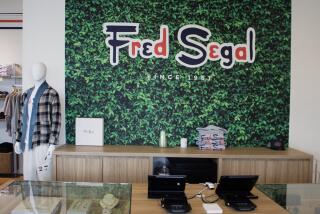Lessons the American Girl store can teach Silicon Valley
PALO ALTO -- Starting about 7 a.m. Saturday in a corner of the Stanford Shopping Center, hundreds of girls under the age of 11 will begin lining up for an event that many of them have been dreaming about for years now: the grand opening of an American Girl store.
Some have set foot in one of the other 15 American Girl stores. But most have not. Crossing the threshold will be their first time inside a retail wonderland that caters to the special relationship they have with the 18-inch-tall doll that is no doubt among their most prized positions.
In Silicon Valley, it’s the kind of retailing frenzy we tend to see only around the launch of a new Apple product, like an iPhone or iPad. Or, this month, that we’re seeing with the release of the gaming consoles from Microsoft and Sony that spark lines and midnight releases.
Otherwise, American Girl dolls would seem to be the antithesis of everything this region is about. Buying a doll -- even a pricey one like these, which start around $110 -- seems so old school in an era where everything is increasingly virtual.
Yes, American Girl has a handful of apps and online games. But the experience is still all about the doll and the bond created with young girls. That includes my 8-year-old daughter who has two dolls and a host of accessories.
On Thursday I got to tour the new store in advance of the grand opening. I decided to bring along my daughter, Kalian, 8, to lend her American Girl expertise. She, in turn, brought along her doll, Caroline. For the last several week, the opening of this store is pretty much all Kalian and her friends have been discussing.
I figured it would be a fun outing. And I was certainly curious, given the American Girl fever among her friends.
As a technology and business reporter, I also couldn’t help but see and hear some things at the store that I think offer some interesting lessons for Silicon Valley. In particular, the visit had me thinking about some interesting parallels with Apple.
First, for the uninitiated, American Girl was created in 1986 by Pleasant Rowland, a Madison, Wis., educator who thought that a line of dolls could inspire young girls to learn more about history. In 1998, she sold the company to Mattel for $700 million.
One of the important things to know about American Girl, and one of the things that’s made our family more comfortable with the brand, is that many of the traditional dolls come with elaborate stories that illuminate not just history but also real social issues. For instance, at home we have the series of books about an African American doll named Addy that explore slavery.
Other dolls and their stories explore poverty, homelessness, child labor and animal rights. There has been some criticism that Mattel has deemphasized these types of stories in favor of less controversial ones. Still, the main featured doll this year, Saige, comes with a story about how her school’s budget is being cut and how she tries to fight back.
In any case, these stories are an essential part of the American Girl experience. It’s something that really drives the connection between girls and their dolls.
This is where the first lesson comes in for Silicon Valley. Just recently, I was reading a new biography of Apple design guru Jony Ive by Leander Kahney. In the book, when thinking initially about a new product, Apple designers spend a lot of time asking: “What is the story that people will tell about it?”
That is the starting point to understand the emotional connection before they even get into features and design and the technology. It’s Apple success at thinking about that question first that also results in the extreme passion many people feel for Apple products.
The next lesson has to do with the store’s very existence. We’ve been hearing about the death of bricks-and-mortar retailing for years now. But the two-story, 15,000-square-foot American Girl store is a reminder that there is still a hunger for real-world shopping experiences.
In this case, American Girl has embraced the trend of “experiential” retail. Yes, you can buy dolls there, along with accessories, but I seriously doubt that they drive a significant portion of American Girl revenue. Most dolls are sold through the website or the mail-order catalog.
Instead, the stores are primarily an extension of the original purchase. On the second floor of the new Stanford store is a spa area where American Girl dolls can get their hair done, get cleaned up and even get their ears pierced.
Around the corner in the store is a bistro. Reservations at the new Stanford store are pretty well booked up for the next three months. And of course there’s a separate room that can be booked for birthday parties.
It makes me think of the new Apple store that opened in September just a few hundred yards away in the Stanford Shopping Center.
That store features what Apple calls a pavilion design. There is a front room, where the gadgets are on display. Then there is a back room designed for service, the Apple Genius Bar, workshops and other educational purposes.
Although there are some products on display in the back, it’s not really the emphasis. It’s mostly a big space with long wooden tables designed to hold workshops, tutorials and other types of meetings. In other words, the types of things that you don’t pay for but that make you more willing to pay the premium price Apple products command.
One of the most surprising things about the new Silicon Valley American Girl store is that it took so long to open a store here. But in fact, that slow pace is deliberate.
According to Stephanie Spanos, the American Girl spokeswoman who gave us the tour, the company is likely to build only 20 stores total. Palo Alto is store No. 16, and there are ones planned for Charlotte, N.C., and Orlando, Fla., in the next couple of years.
The intention is to make the stores destinations rather than trying to build one on every corner. That means the Palo Alto store is likely to be be the only one built in Northern California. It took us more than an hour to drive there from our house in Oakland, and you can bet that many other families will drive several hours just to visit.
This an interesting lesson. Rather than saturating the map or sticking the dolls in every retail outlet, the company maintains a kind of mystique by keeping the stores scarce.
This kind of decision clearly is not the kind of thinking driven by bottom-line-first management philosophy. That also reminds me of Apple -- don’t worry about selling the most; just focus on the experience first, and the sales will take care of themselves.
It’s this kind of approach that creates the kind of obsession in kids like mine and the unusually intimate bond they form with an inanimate object, albeit one that’s more human in shape than a smartphone. It’s why this weekend, projections are that about 10,000 people will visit the new American Girl store in two days.
And it’s why, as we drove home from the store, my daughter was beaming. Not for herself, mind you, but because she was so happy her doll got to visit the new store.
“This was a really special day for Caroline,” she said.
“What about you?” I asked.
“Today was really all about Caroline.”
ALSO:
Google brings All Access music subscription service to iPhone
iPhone 5 still available at Wal-Mart, starts at $29 with contract
Facebook removes controversial line about teens in privacy policy







